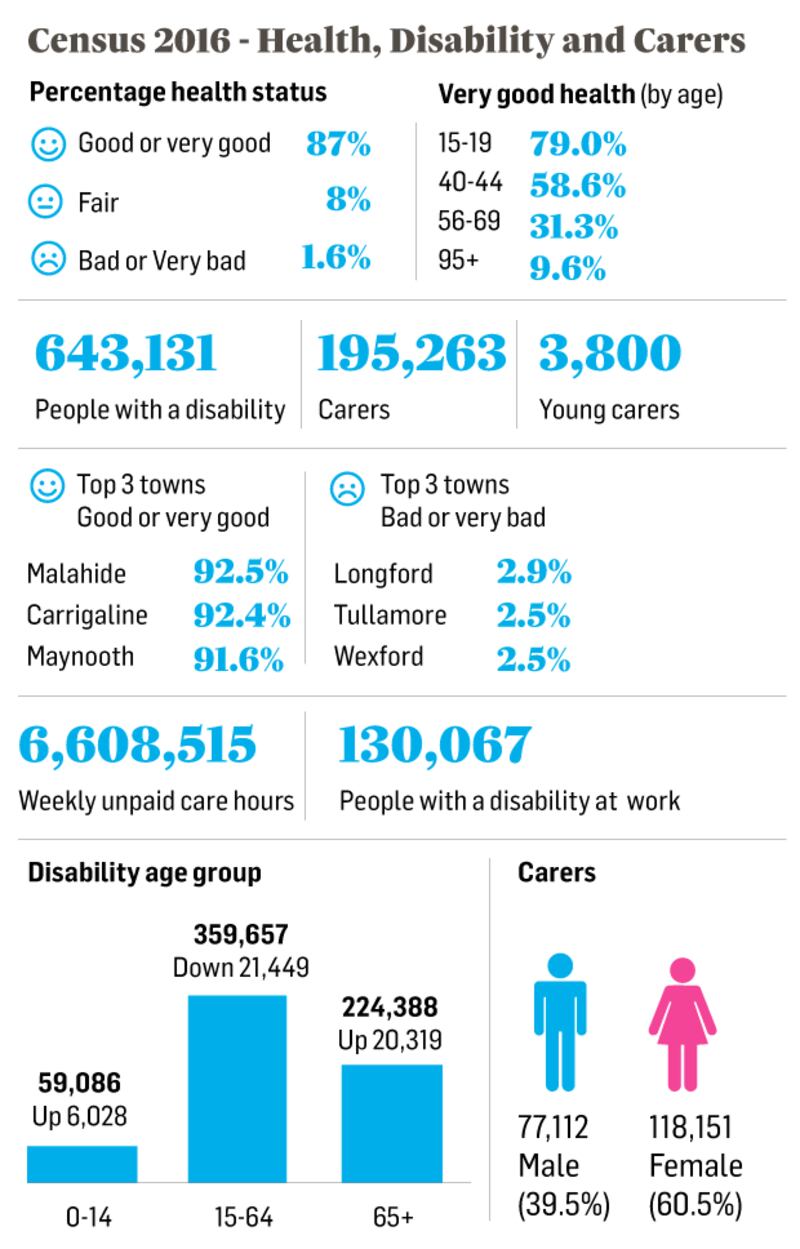There is a significant difference in people’s view of their health depending on where they live, according to latest figures from Census 2016.
Nine out of 10 people in the Dún Laoghaire-Rathdown area reported their health as being good or very good, the highest in the State, the Central Statistics Office report says.
The second highest was Co Meath, where 89.6 per cent of people who completed the Census last year said their health was good or very good. These were followed by Co Kildare (89.5 per cent) and Cork county (89.5 per cent).
The area where people considered themselves to have the lowest level of good health was Dublin City (82.8 per cent), followed by Cork City (83.6 per cent), and Co Longford (85.3 per cent).
The report also shows that the number of people who reported having a disability has increased in the last five years by almost 50,000 from 595,335 to 643,131. The number of people with a disability who reported having a psychological or emotional condition increased by nearly a third, to 123,515.
The statistics also show more people over the age of 50 are becoming unpaid carers. In the last five years 12,408 more people over the age of 50 became unpaid carers, while the number of carers between the ages of 20 and 49 declined. The number of carers over the age of 85 increased by 34 per cent. Women provided two-thirds of all unpaid care hours in Ireland last year, the figures show.

Employment
The study outlines a link between a person’s employment and their perceived health. In total 96 per cent of workers classed as “professional” said they were in good or very good health. This fell to 83 per cent among “unskilled” workers.
The statistics show 0.5 per cent of professionals described their health as bad or very bad, compared with 2.6 per cent of unskilled workers.
The town where residents had the best view of their health in Ireland was Malahide in north Co Dublin, where 92.5 per cent of residents described their health as good, and less than 1 per cent said their health was bad or very bad. This was followed by Carrigaline in Co Cork (92.4 per cent) and Maynooth, Co Kildare (91.8 per cent).
People living in disadvantaged areas in west and north inner-city Dublin reported significantly higher rates of poor health than other parts of the capital, with 4.1 per cent of residents in Kilmore saying their health was poor, eight times higher than the most affluent areas in Dublin.
In Cork city 3.4 per cent of people in the Churchfield area described their health as bad, as did 3.5 per cent of people living in Blackpool. In Douglas, just outside Cork city, 0.9 per cent of respondents said their health was poor.
In Limerick city 5.8 per cent of people in Farranshone electoral division, near Thomond Park, said their health was poor, as did 4.5 per cent of people in the Rathbane area. In the Laurel Hill area outside of the city centre only 0.9 per cent of people described their health as poor.
Residents in affluent areas in the south of Dublin reported low levels of poor health with just 0.5 per cent saying so in Foxrock and 0.6 per cent in Killiney.
People living in rural areas reported on average better health than those recorded as living in urban cities and towns.
In Co Kerry, 3.1 per cent of people living in the urban centre of Tralee said they were in bad health, compared with 1.9 per cent of people living in the area outside of Tralee town.










